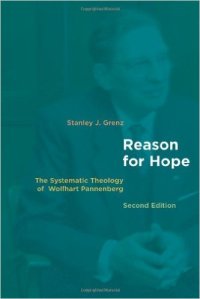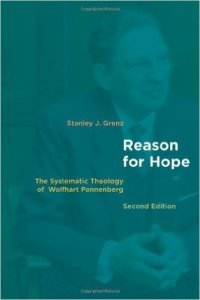 This is the first in a six-post series on Stanley Grenz’s book, Reason for Hope: The Systematic Theology of Wolfhart Pannenberg. I highly recommend the book to all who are interested in learning more about Pannenberg’s method and theology, broken by Grenz into six chapters on method, the Doctrine of God, Creation and Humanity, Christology, Ecclesiology, and Eschatology. I can see why this book is considered to be one of the best in English on Pannenberg’s systematic theology and it was blurbed by Philip Clayton, Leron Shults, and Pannenberg himself.[1] I can also see why Pannenberg was recommended to me, a scientist, as the systematic theologian most worth engaging.
This is the first in a six-post series on Stanley Grenz’s book, Reason for Hope: The Systematic Theology of Wolfhart Pannenberg. I highly recommend the book to all who are interested in learning more about Pannenberg’s method and theology, broken by Grenz into six chapters on method, the Doctrine of God, Creation and Humanity, Christology, Ecclesiology, and Eschatology. I can see why this book is considered to be one of the best in English on Pannenberg’s systematic theology and it was blurbed by Philip Clayton, Leron Shults, and Pannenberg himself.[1] I can also see why Pannenberg was recommended to me, a scientist, as the systematic theologian most worth engaging.
Today we will talk about method. Readers of this blog know that I greatly appreciate conversation on method. My movement from the practice of science to discussion of science and theology was greatly aided by reading Nancey Murphy’s seminal book, Theology in the Age of Scientific Reasoning.[2] In this book, Murphy applied Lakatosian philosophy of science to theology in the hopes that it would provide theology with an epistemological standing appropriate to the “scientific age” with its focus on probabilistic reasoning. She treated Pannenberg’s method as a Lakatosian “research program” and believed that this “scientific theology” once and for all met Hume’s philosophical challenges to theology (the move from study of authorities and deduction from their arguments to induction based on empirical data; the inability of miracles to validate revelation, etc.). Since then, Murphy has pulled back from using Lakatosian philosophy of science and prefers application of Alasdair MacIntyre’s tradition-based method, but that is a post for another day.[3] The important point is that if one wants to have a constructive dialogue on science and theology or just wants theology to be informed by science (and vice-versa) one needs to identify a method suitable for the task.
Pannenberg most definitely sought dialogue between the disciplines, though this derived mostly out of a desire for theology to be considered worthy of discussion in the public sphere. He abhorred the privatization of theology and was greatly concerned by its “retreat” to the individual or subjective realm. As such, Pannenberg’s method was broad in scope and he understood God as the power that determines everything.[4] His view of revelation was likewise broad and included both history and Scripture. Because history is not complete, our knowledge of God is provisional and will not be completely demonstrated until the eschaton.[5] However, we have seen a glimpse of the end already in the life, death, and resurrection of Jesus Christ, which gives us hope. Amazing hope.
Because Pannenberg’s is a public theology, it is focused on reason. As Grenz writes, “The task of systematic theology, as the demonstration of the illuminating power of the concept of God, is fulfilled as Christian doctrine is shown to cohere with all human knowledge.”[6] Whether Pannenberg has succeeded is up for debate, but his view of the church, desire for theology to regain its academic perch, and belief that God is the power that determines everything demanded nothing less. “As a people of hope whose eyes are directed to the eschatological consummation in the kingdom of God, the Christian community may not retreat into a privatized ghetto of individual or familial piety but is called to remain in the world to give reasonable account of the hope that characterizes its life.”[7] Preach.
Pannenberg seeks to connect with the Christian tradition, which sees God as “the all-inclusive object of theology.”[8] He does not ignore the modern and post-modern understanding of truth, however. He uses Scripture as a primary source of revelation but rather than presuppose the Bible as inspired, he believes it should be the goal of the theologian to show that Bible is inspired by demonstrating how theology coheres with what we know from other disciplines and historical progression.[9] This places a significant burden on the theologian and may strike some Christians as dangerous, but he deems it necessary for theology to regains its place as a public discipline. And I would argue this is essential if Christians want theology to have a cognitive component in addition to being about “God feelings” and experiences.
Pannenberg views the philosophical concept of God as an ally, but not in the realm of natural theology-based proofs from centuries prior. He stands on the foundation of prior attempts to connect the one God of philosophy with Jesus by means of the Logos in the early church. But he doesn’t believe that this is an apples to apples discussion. Instead, the philosophical concept of God can “function as a criterion for God-talk” and revealed theology “brings to explicit ‘thematization’ the implicit awareness of the infinite.”[10] So there is a God-shaped hole in all of us[11] but it can only be appropriately filled by God’s revelation mediated by the Christian tradition. This allows for interaction with other religions as well, since our understanding of God is always provisional and will only be complete in the eschaton. Surely there is something to be gained by engaging with what other religions say about God, though Pannenberg believes that the Judeo-Christian tradition best coheres with what we know about the world and that Jesus Christ was and is the preview of what is to come.
Since Pannenberg sees both history and Scripture as revelation, he then proceeds to compare religious traditions throughout human history. He does not do so to identify a “common essence of religion,” but believes that because humans are by nature, religious, and God is the power that determines everything different religions will necessarily reveal something about God.[12] Pannenberg sees three advancements for theology in the Judeo-Christian tradition summarized below.
- The movement from belief in many gods to one god.
- The demonstration of God’s activity in history. In Grenz’s words, “In this tradition, the question regarding a final self-demonstration of God was raised, and Israelite history, including its future, came to be seen as the history of the appearance of God. This provides the context for Pannenberg’s understanding of revelation (developed more fully in the fourth chapter) as the coming into appearance of the divine reality even in the midst of the unconcluded conflict of religious and ideological truth claims.”[13]
- The movement from mythical past to eschatological future.
Revelation to Pannenberg means something different than I think most Christians would anticipate, and Grenz notes that attacks have come at Pannenberg from multiple sides. Revelation refers to God’s self-disclosure (so far so good) and it can be found in both Scripture and through historical study. There is a historical progression of God’s interaction with the world that can be ascertained by all, not just Christians and not just through reading of Scripture. This is why Pannenberg finds the study of other religious traditions useful. In the end, though, he believes that the Christian doctrine as revealed by God is the most coherent and it is the role of dogmatics to demonstrate this. Akin to a natural science, the Bible and history (the data) are used to generate doctrinal truth (the theories).
We’ll start with one of these doctrines next week, the Doctrine of God.
————————————————————————–
[1] “This book provides a correct picture concerning the overall synthesis of my theology.” Wolfhart, you’re not helping to repaint the picture of systematic theologians as dry and German…
[2] Nancey Murphy (1993). Theology in the Age of Scientific Reasoning. Cornell University Press.
[3] Nancey Murphy (2007). Wind and Spirit: A Theological Autobiography. Dialog: A Journal of Theology 46: 301-310. See also: Nancey Murphy (2010). Robert John Russell Versus the New Atheists. Zygon 45: 193-212.
[4] Stanley Grenz (2005). Reason for Hope: The Systematic Theology of Wolfhart Pannenberg. Wm. B. Eerdmans Publishing Company. p 7.
[5] Ibid. p 7.
[6] Ibid. p 8.
[7] Ibid. p 9.
[8] Stanley Grenz (2005). Reason for Hope: The Systematic Theology of Wolfhart Pannenberg. Wm. B. Eerdmans Publishing Company. p 14.
[9] Ibid. p 16.
[10] Ibid. p 24.
[11] Classic!
[12] Stanley Grenz (2005). Reason for Hope: The Systematic Theology of Wolfhart Pannenberg. Wm. B. Eerdmans Publishing Company. p 28.
[13] Ibid. p 30.

Justin,
I’ve begun reading Pannenberg and have appreciated his perspectives. Did you ultimately publish the blog posts you reference in -Method (post 1). I am not finding them and would appreciate a link if they exist.
Thanks!
Gregg
LikeLike
Hi Gregg,
I didn’t. I ended up getting too busy with my day job and just couldn’t keep up with it. Ironically, I just started rereading the book recently and may try to revive the blog over the Christmas break.
Justin
LikeLike